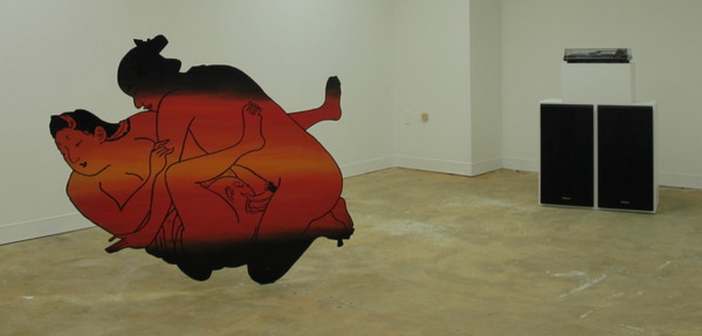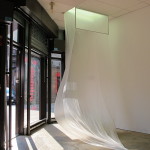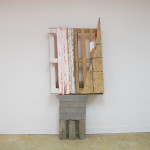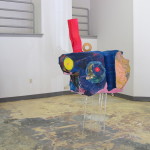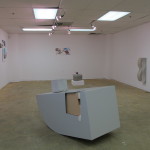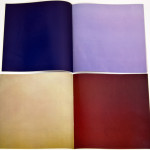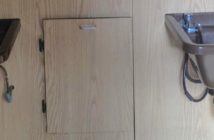Titled not without a little irony, Bricks and Mortar, a pop-up show lasting just over one week, was anchored by the least physical work in the exhibition: a sound installation. Taking on the characteristics of the space that tries to contain it – in this case, a former office suite at 225 Friend Street with low-hanging ceiling tile and a cement floor showing traces of dried glue and carpeting – the slow mechanical drawl of a looping song echoes off the walls, affecting everything around it. Though I regretted the absence of more visitors, I was lucky to witness the show totally alone, as opposed to during an opening or closing party when, in the din of chatter, the effect would be lost.
It's gettin' dark, too dark to see. I feel I'm knocking on heaven's door. Dylan's 45, slowed to 33, rang out with the same eerie sadness of HAL 9000's swan song, A Bicycle Built for Two. Slowing the record had the effect of making the song seem heavy, palpable, thick like a drunkard's voice. It stripped the ballad of all its nasal Dylan-ness, turning it from a sheriff's to a machine's last stand. Odd how we anthropomorphize the sound of a machine slowing to the point of feeling pity.
I'm afraid. I'm afraid, Dave. Dave, my mind is going. I can feel it. I can feel it. My mind is going. There is no question about it. I can feel it. I can feel it. I can feel it. I'm a... fraid.
The turntable, set on an immaculate white box containing two identical speakers faced two life-size reproductions, on die-cut aluminum, of Japanese woodcuts showing couples in coitus. In each, the woman looks away from the man, suggesting a disturbing attempt at detachment, as though the act weren't mutually pleasurable or desired. The thick dark lines of the drawing are overlaid on post-apocalyptic sunsets – a cross between an Ed Ruscha / Bruce Nauman (L.A. Air) sky and a forest fire, where the particulate pollution is so dense that it refracts light in unnaturally saturated colors.
The aura of foreboding generated by collaborating artists Kyle Nilan and Nick Sullivan in that back room radically affected my reading of the rest of the show – perhaps because I share much of the pessimism about the state of nature and mankind's blithe dismissiveness of our role in bringing it upon the world. From the room emanated the same sad sense of shame depicted in Steve McQueen's eponymous film, in which people fuck each other in and out of oblivion, caught in their own private circle of hell.
Much of the other work in the Arca Archa space exhibited self-reflexive qualities (objects that explore the materials they are made of and the process of being made – the kind of man-made self-awareness of a 'living' machine) and optimistic up-cycling of trash and leftovers. The difference with earlier instances of self-reflexive art is that many of the cheap materials used by artists today were not simply factory-produced but had been used prior to being incorporated into artworks, were found and hoarded, and have morphed into weird, non-sensical, utterly useless frankensteins via material cross-breeding (glass and foam, cement and wood, gesso and wax) and palimpsest. There were some beautiful monsters in this show – a plastic annunciation descending from a collapsed light fixture; a colorful foam hybrid teetering on glass stilts – that seemed right at home in the defunct mess of an office complex, while other pieces, overwhelmed by the hollow fluorescent light and dropped ceiling, uncannily looked coughed up by the walls themselves.
Two pieces stood out owing to a more polished, formal quality while sharing the playful approach to material. With the way she combines and cuts away at cement and painted wood, Jessie Vogel seems to be developing her own physical lexicon. Her sculptures merge elements and put their relationship to the test. Materials are perfectly married, natural in each other's company, indivisible and yet totally at odds, as though the slightest change in circumstance would upset a very delicate order.
Curated by four MassArt graduate students, this was the fourth pop-up at Arca Archa – a cycle that started with Susan Metrican's excellent Hung Jury last spring, thanks to initiative from local realtors, the artists themselves and Jenny Gibbs, Assistant Dean of the Graduate Programs. Funded by a Kickstarter campaign, the curator-artists hosted the work of their peers from Boston, New York, Texas and Ireland.
The shows in this alternative space reflect the energy and economy of self-starting collectives. In the midst of a 'culture war' and in the face of frugally-supportive government, artists are demonstrating how to make space for themselves by staking a claim on all that's overlooked, even if it will only last temporarily.
- Kyle Nilan. Cabinet. Turntable. Audio Nick Sullivan. Aluminum, enamel
- Clive Moloney. Plastic, fan, light source
- Loney Abrams. Pallet, paint, tape, cement blocks
- Zachary Herrmann. Foam, paint, glass
- Jessie Vogel. Wood, cement, paint
- Ross Normandin. Paint on board
- Upstairs space with works by Jessie Vogel (foreground), Landon O’Brien (background on floor), Jon Waites (right wall), Ramon Kassam (left and back wall)
- Bruce Nauman, L.A. Air. New York: Multiples Inc., 1970.
- Ed Ruscha, END, oil on canvas 36 x 40 inches 1983 Image courtesy of the artist
Bricks and Mortar popped up at 225 Friend Street, Boston, from August 24 through September 1, 2012
The curator-artists were:
Clive Moloney, clivemoloney.blogspot.com
Zachary Herrmann
Nick Sullivan
Jessie Vogel, jessievogel.com
Their guests were:
Loney Abrams loneyabrams.com
Ramon Kassam ramonkassam.com
Landon O’Brien
Sarah Witt, thesarahwitt.com
Ross Normandin, rossnormandin.com
Jon Waites, jonwaites.com
Andrea Sparks
Kyle Nilan
All images, excepting Ed Ruscha and Bruce Nauman works, are courtesy of Stephanie Cardon and the artists.

